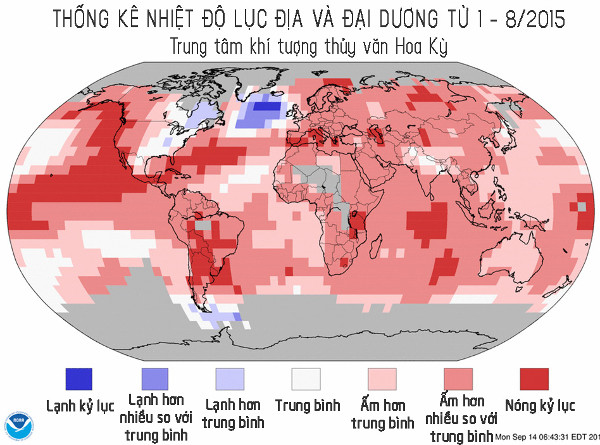Climate change makes the surface temperature of Greenland sea surface unusually low
While temperatures in many parts of the world reached record highs in 2015, strangely, a region south of Greenland reached the lowest temperature. Scientists fear that this is a sign that the giant ocean currents in the North Atlantic have slowed down due to the tremendous amount of ice that has melted and the effects of climate change are increasingly frightening. than.
The temperature of the sea surface in Greenland falls to a record low
Since the beginning of this year, scientists at the US Hydrometeorological Center (NOAA) have been monitoring and detecting an abnormal temperature drop in the waters south of Greenland and Iceland, some of which are still reached the lowest temperature in the last 8 months. It is worth mentioning that this happened during the summer, when temperatures in most parts of the world hit record highs.

Statistics of global temperatures in 2015, blue round spots are located in Greenland, corresponding to abnormal cold temperatures.
Before this phenomenon, scientists have provided a possible explanation that the giant ice blocks in Greenland melted and poured into the sea, disrupting the mechanism of controlling ocean currents due to thermal energy in Bac Dai. Atlantic Ocean. The mechanism that makes this huge flow is the amount of cold sea water , high salinity at the surface will go down to the bottom of the sea. Seaways play a very important role in determining the climate of continents.
However, scientists fear that the mechanism has been disturbed by the cold water from the ice sheets melting. The fresh, low temperature layer will remain on the sea surface without moving downwards (concentration gradient) and this will disturb the operation of the ocean currents.
Earlier this year, scientists at Met Office Hadley Center led by Professor Leon Hermanson published a study showing Atlantic ocean currents - warm, salty water, on the surface in the north and cold, deep the seabed in the south - was delayed by 15 to 20% during the 20th century. On the other hand, they believed that strong winds blowing through the Atlantic Ocean also contributed to this phenomenon.
Scientists believe that if the ice continues to melt, meaning that the Earth continues to heat up, the same phenomenon will occur in many other places on Earth, not just in Greenland. Although its influence is not terrible at the present time, as it continues, sea water not only submerges the continent but also causes a series of other extreme weather events in the future.
- Half of the cause of Greenland warming is natural
- Greenland Island will be completely transformed by 2100
- Greenland ice is constantly melting
- See the beautiful Greenland, but it can soon be lost forever
- The largest ice island emerged because of climate change
- Greenland Glacier shattered, a clear sign of climate change
- Warming temperatures change the face of Greenland
- People and the sea change the climate of North America over the past 50 years
- Earth's temperature changes abnormally hot and cold
- Elevated Earth temperature makes the lizard change sex
- Sun 'does not change climate'
- The 'alien' spectacle in the world's largest island
 Is the magnetic North Pole shift dangerous to humanity?
Is the magnetic North Pole shift dangerous to humanity? Washington legalizes the recycling of human bodies into fertilizer
Washington legalizes the recycling of human bodies into fertilizer Lightning stone - the mysterious guest
Lightning stone - the mysterious guest Stunned by the mysterious sunset, strange appearance
Stunned by the mysterious sunset, strange appearance Why do Greenland and Iceland have names that are completely opposite to their reality?
Why do Greenland and Iceland have names that are completely opposite to their reality?  This is a shark that can live for hundreds of years
This is a shark that can live for hundreds of years  The ice in Greenland melts from bottom to top, faster than ever
The ice in Greenland melts from bottom to top, faster than ever  Greenland's huge freshwater reserve is losing 357 billion tons of ice every year
Greenland's huge freshwater reserve is losing 357 billion tons of ice every year  Greenland Sharks: The key to the longevity of humanity in the future?
Greenland Sharks: The key to the longevity of humanity in the future?  The mystery of the warrior family disappeared because of an extinct creature
The mystery of the warrior family disappeared because of an extinct creature 